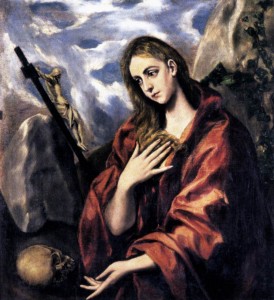 Poor Mary Magdalene. I think she would have a thing or two to say about how she is portrayed today by many who have an “agenda” regarding the “proper” role of women in the church.
Poor Mary Magdalene. I think she would have a thing or two to say about how she is portrayed today by many who have an “agenda” regarding the “proper” role of women in the church.
The examples I could name are many, from the recent portrayal of the saint as implied “leader” of the disciples (even over the twelve) in the History Channel’s series “The Bible,” or Dan Brown’s insinuation of her nuptials with Jesus in the Da Vinci Code novel at the beginning of the millennium, to the homily I heard during a weekday Mass this last week from a priest at a local parish, in which he called her a “Church of One” following the resurrection, assigned a privilege not given even to the Mother of God…
Heaven help us…Mary Magdalene, pray for us.
During Easter break, my family had the privilege of hosting two of the Immaculate Conception Program students at our home, and I had taken them with me to this Mass. After hearing the homily, the catechist in me felt it necessary to discuss with them, as well as with two of my daughters who were also present at the Mass, what this priest had said. To their credit, when the priest made his statements, the girls all looked at me quizzically as if to ask “Is what he is saying true?”
Everything inside me was screaming “No!” but I kept calm, and later that day, I did some research to confirm what I already knew about the ongoing traditional understanding of our Church regarding who Jesus appeared to after he resurrected, and the proper role of Mary Magdalene as Apostle to the Apostles, and the role of Mary as Mother of the Church.
On this occasion of the day our Church honors the Blessed Virgin in her role as the FIRST TO BELIEVE (though usually recognized on March 25, the feast of the Annunciation was moved to today, April 8, because the date fell during Holy Week this year) I wanted to share what I found from a source whose opinion I give much more relevance to than those previously listed – Pope John Paul II.
 I refer to his document Mary was Witness to the Whole Paschal Mystery I discovered on the EWTN website.
I refer to his document Mary was Witness to the Whole Paschal Mystery I discovered on the EWTN website.
Here are a few excerpts:
If the authors of the New Testament do not speak of the Mother’s encounter with her risen Son, this can perhaps be attributed to the fact that such a witness would have been considered too biased by those who denied the Lord’s Resurrection, and therefore not worthy of belief….
St Paul recalls that he appeared “to more than 500 brethren at one time” (1 Cor 15:6). How do we explain the fact that an exceptional event known to so many is not mentioned by the Evangelists? It is an obvious sign that other appearances of the Risen One were not recorded, although they were among the well-known events that occurred. How could the Blessed Virgin, present in the first community of disciples (cf. Acts 1: 14), be excluded from those who met her divine Son after he had risen from the dead?
Could not Mary’s absence from the group of women who went to the tomb at dawn (cf. Mk 16: 1; Mt 28: 1) indicate that she had already met Jesus?
Lastly, the unique and special character of the Blessed Virgin’s presence at Calvary and her perfect union with the Son in his suffering on the Cross seem to postulate a very particular sharing on her part in the mystery of the Resurrection. It seems reasonable to think that Mary, as the image and model of the Church which waits for the Risen One and meets him in the group of disciples during his Easter appearances, had had a personal contact with her risen Son, so that she too could delight in the fullness of paschal joy.
To this wisdom, I want to add what I have learned in my own reflection of that morning of the Resurrection, considering what it must have been like for Mary to meet with her Son. The meeting must have been so special it could not be described in words…
Our Blessed Mother, who said, “Do whatever He tells you,” at the Wedding at Cana in the Gospel of St. John, would likely not have run out to share the news of her meeting with others, as Jesus had commanded Mary Magdalene and the other women he met to do. It was Mary who “pondered in her heart,” remember? However, the Apostle to the Apostles was given the privilege to run to the twelve and announce “I have seen the Lord!”
Why does it even matter which woman saw Jesus first, anyway? The reason lies in the intention of those sending the message. Is that message their own, or is it from Jesus? Consider the role He has assigned to each one of us. We must prayerfully ponder, as did our Blessed Mother, our own particular evangelical role in our Church today. And in our own way, we must go out and proclaim the words of Mary Magdalene to the world desperately in need of our witness.
